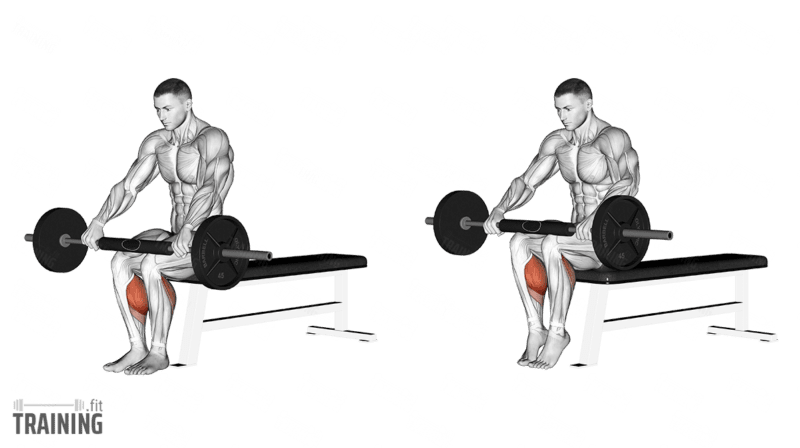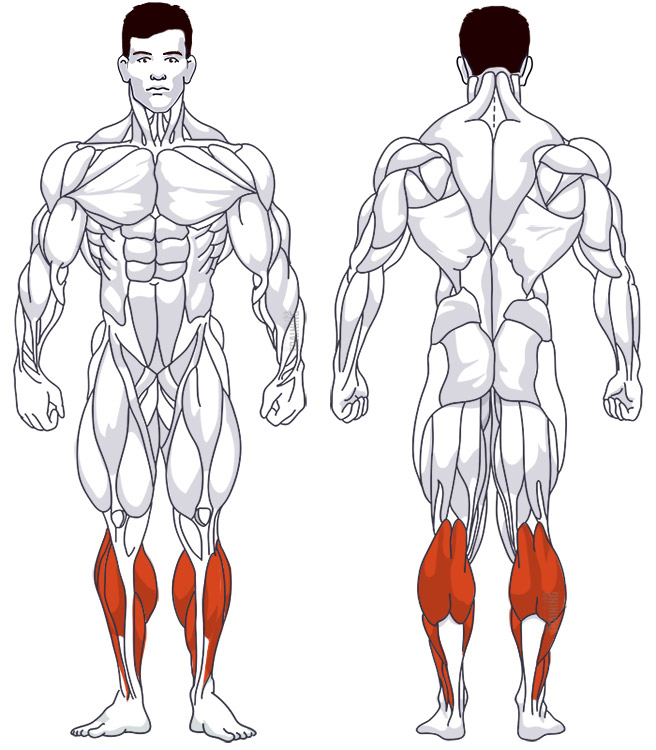Seated Barbell Calf Raise
Isolation exercise, Free weightsOverview

Main muscles
- Lower leg: Short fibula muscle
(Musculus peroneus brevis) - Lower leg: Long big toe flexor
(Musculus flexor hallucis longus) - Lower leg: Long fibular muscle
(Musculus fibularis longus) - Lower leg: Long toe extensor
(Musculus extensor digitorum longus) - Lower leg: Soleus muscle
(Musculus soleus) - Lower leg: Anterior tibial muscle
(Musculus tibialis anterior) - Lower leg: Twin calf muscle
(Musculus gastrocnemius)
Training plans
Seated Barbell Calf Raise is a suitable substitute for similar exercises in or as a supplement to various training plans.
Seated Barbell Calf Raise: Basics and alternatives

Involved main muscle groups:
Seated Barbell Calf Raise
Seated barbell calf raises are a great alternative to the machine version. The basic movement remains the same: while sitting, you move the weight resting on your thighs by raising and lowering your heels.
This exercise comes in handy as an alternative to the machine, especially when training at a home gym or if the machine is occupied at the fitness studio.
Other options include the standing barbell calf raise, seated dumbbell calf raise, or the less common donkey calf raises. You can also perform calf raises without equipment, which is useful for volume training.
Correct Execution
Although you can place the barbell directly on your thighs, doing so might be uncomfortable over time or with heavier weights. Using a barbell pad or a towel wrapped around the barbell can help alleviate discomfort.
Position the barbell just behind your knees on your thighs, and avoid resting it directly on your knees. When positioning, secure the barbell with your hands to prevent it from rolling forward over your knees.
Instead of resting your feet on the ground, as in seated dumbbell calf raises, you can place your forefoot on a weight plate. This increases the range of motion and muscle stimulation.
Video Tutorial
Step-by-Step Instructions
Grab the barbell with an overhand grip and hold it in front of your body.
Sit with an upright back at one end of the bench and rest the barbell centered behind your knees on your thighs.
Place your feet about shoulder-width apart on the ground. Bend your knees so that your lower and upper legs form a 90-degree angle. You’re now in the starting position.
Lift the weight by extending your ankles, raising your heels, and shifting the weight onto the balls of your feet and toes. Lift your heels as far as possible without discomfort. Keep holding the barbell with both hands in the overhand grip.
Hold the extended ankle position for a moment, then lower the weight back to the starting position.
Common Mistakes
When using a weight plate as a base for your feet, dropping the weight suddenly can lead to ankle overstretching. Make sure to move the weight slowly and in a controlled manner to avoid injuries.
Proper form is also crucial for the effectiveness of barbell calf raises. Using too heavy weights might tempt you to use your upper body to help raise the weight. Avoid this – the barbell should only be moved by extending and bending the ankle.